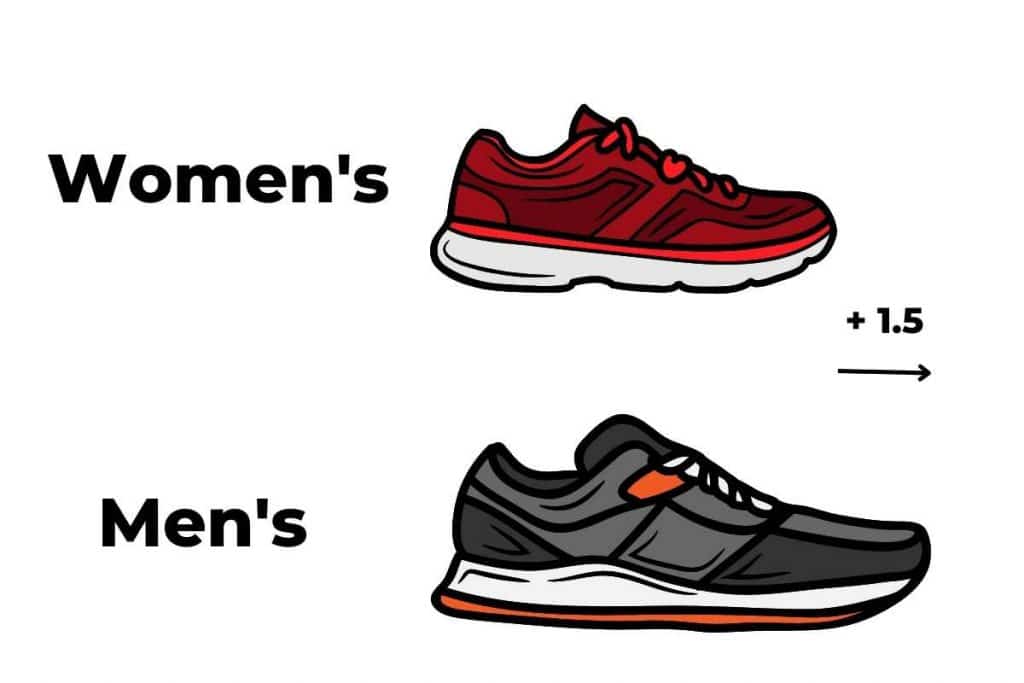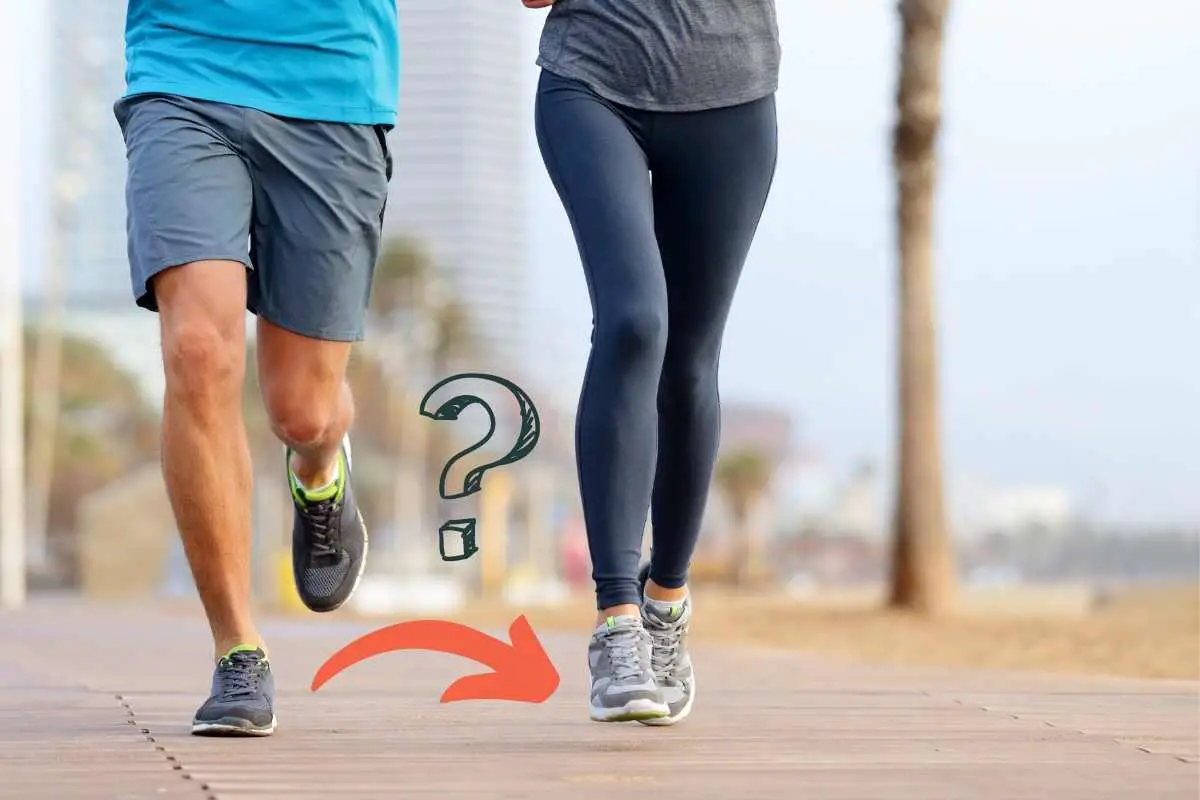Men and women run in a slightly different ways.
The angle at which the foot hits the ground, the amount of force applied, and the foot shape is all gender-specific.
That’s why there is a distinction between male and female running shoes, to customize foot support and optimize comfort. But what are the biggest differences between men’s and women’s running shoes?
Female shoes tend to be narrower, with a smaller heels. Women’s running shoes have more cushioning and support, as women tend to tip their ankles inward when running.
Male shoes tend to be heavier to compensate for the increased impact force. Generally, men will have larger shoes than females.
I’ve found that getting the right type of shoe can make a huge difference when running. That’s why manufacturers have put so much effort into crafting shoes that give men and women the support they need. Read on to learn more about how to find the ideal running shoe for you.
Main Differences Between Men’s And Women’s Running Shoes
There are several differences between men’s and women’s running shoes; these are some of the most substantial differences:
- Shape. Female shoes tend to be wider in the toe while narrower in the heel. Male feet are also larger than women’s, so male shoes tend to be longer and wider.
- Type of cushioning. Women tend to have wider hips than men. Because of this, they have a slightly different way of walking. Women are more likely to pronate, tipping their ankles slightly inwards as they walk. As a result, they will need more soft cushioning and support in their shoes.
- Amount of weight they can cope with. Manufacturers must consider the force of impact their shoes will experience when running. Because men weigh more than women, male shoes must be able to cope with higher impact forces. As a result, they tend to have denser cushioning.
- The angle of the heel. Women tend to have smaller heels than men, so their shoes are much narrower. Plus, men tend to hit the ground with their feet at a more upward angle, so they need a wider heel to accommodate them.
- Design. The aesthetics of the shoes won’t have any impact on running performance. But it is often used as a way to distinguish the target audience.
Just choosing the right shoe for your gender won’t be enough. You might also need to adjust them a little to ensure they fit you properly. There are a few ways that you can do this. You might want to use innersoles. You might want to replace them at other times to get a tighter fit.
There are a few reasons why it’s recommended that runners always use shoes that fit them; these include:
- Protecting yourself from injuries. Your foot won’t get the support it needs without the right cushioning and shape. This will become especially noticeable when running, as you’ll be placing a lot of pressure on your feet. If you’re not careful, this can lead to blisters and other uncomfortable ailments.
- Improving performance. With the right kind of support, you should be able to become more efficient. For example, some shoes might come with cushioned midsoles to reduce the amount of effort you need to exert when running. At other times, your shoes might be able to help you correct your gait.
- Reduces impact on knees and ankles. Running can have a big impact on your ankles and knees. The cushioning in your shoes will help you lessen these blows.
Can A Man Wear Women’s Running Shoes?
Men can wear women’s running shoes. In some cases, men with narrow feet or thin heels might benefit from the additional support women’s shoes can provide. However, they might need to adjust the shoes slightly to accommodate the narrow width.
It may be worth reading my other article on how to know if your running shoes are too big.
In some cases, a man might benefit from wearing women’s running shoes. Usually, this is done by men with narrower feet and thinner heels. They might struggle to get the support they need from men’s shoes.
It’s also possible that women’s shoes might be useful for men who have smaller feet. This can limit their choice in the men’s running shoe range.
One of the biggest objections that men will have, though, is the shoe’s aesthetics. The good news is that most manufacturers will offer a more neutral color palette. You should be able to find shoes that come in dark blues or blacks.
Sometimes, though, the shoe will be too narrow to be comfortable. In this case, you can try a few techniques to loosen the shoes up a little. This includes:
- Using a blow dryer. Apply medium heat to the tight portions of your shoes. Blow for 30 seconds at a time. This will cause the shoe to stretch out. This technique works best in leather shoes.
- Placing ice inside the shoe. Put a Ziploc bag filled with a small amount of water in the tight parts of your shoe, then place the shoes into the freezer. As the ice cools, the fabric will stretch out.
- Using shoe stretch spray. Find the spray that matches the shoe fabric; then you should be able to adjust the shoe size easily.
Can A Woman Wear Men’s Running Shoes?
Yes. In some circumstances, women might benefit from wearing male shoes. Most commonly, they will have larger feet and struggle to find women’s footwear that fits them properly. Though they might need to make a few amendments, like adding additional heel support, to get a tight fit.
There are a few circumstances where women might opt to wear men’s running shoes. First, this can be a good solution for women who have larger feet. It might be more comfortable to shift to a men’s size rather than trying to stuff your feet into shoes that are too small for you.
However, there are a few downsides to consider. One of the biggest will be the weight of the shoe. The heavier shoes might slow you down. This can take a bit of getting used to when you are running. Plus, they won’t have the same amount of comfort and support that you are used to.
Another common issue is that women’s feet will be too narrow to fit a male shoe. The good news is that there are some techniques you can use to solve this problem; they include:
- Wearing thicker socks. This can help create a tighter fit if the shoes are a little too wide for your feet.
- Adding band-aids to the heel. Sometimes, the heel will be a little too thick, causing the shoe to rub up and down. Adding a little extra padding can stop this problem.
- Wearing insoles. These are designed to sit at the base of the shoe, taking up any excess space.
I’ve explored these ideas in more detail in my post Can Women Wear Men’s Running Shoes.
Are Men’s Shoes Wider Than Women’s
Men’s shoes are wider than women’s. There are a few reasons for this. First, men tend to have wider feet. The average male shoe width is a D while most females are a B. Secondly, men tend to have larger feet and bigger shoes.
Men’s shoes tend to be wider than women’s shoes. This is because men have large feet than women. Plus, male shoes tend to be larger than women’s. This is why the average women’s shoe width is a B, while the average male shoe width is a D. This difference is around 0.2 inches.
However, the brand will also play a role in determining how wide the shoes will be. Some shoes might be a little wider than others, depending on the type of style they are trying to create. But this will often only be a few millimeters difference.
Does It Matter If You Get Men’s Or Women’s Shoes?
Usually, runners will get better performance from gendered shoes, which have been designed to adapt to each gender’s running style. But the most important thing for runners is to find a pair that fits properly, feels comfortable, and provides the right amount of support.
As we discussed earlier, there are some big differences between male and female shoes. They have been designed with your specific running needs in mind. Because of this, I recommend sticking to the shoes that have been designed to suit your gender. This will be the most comfortable and give you the best performance.
However, there is a limited range of circumstances where you might want to consider swapping with the opposite gender; these are:
- Men with narrower feet, who aren’t getting the heel support they need from male shoes.
- Women with larger feet who are struggling to find a length to suit them in women’s ranges.
Ultimately, you need to find running shoes that work for you. There’s no harm in having a trial period with the other gender’s shoes and seeing how you feel. If the shoes feel good to run in and give you the support you need, it doesn’t matter whether they were intended for males or females.
How To Convert Women’s To Men’s Shoe Sizing?
Women will need to add one and a half sizes to find their male shoe size. For example, a women’s 9 would be equivalent to a male 10.5. The width of the shoe will stay the same. Though there are some slight sizing differences between the shoe brands this often has a negligible impact on the sizing.
Trying to find the right pair of shoes can be a bit tricky. When you’re doing this, there are a few things that you should keep in mind.
First, you need to consider your shoe width. This will be represented by a letter. Most women are B while most men are a size D. Your shoe width will be the same in men’s and women’s sizes.
Now it comes to the shoe size. There is a one a half size difference between the genders. Because of this, if you want to convert a women’s size to a men’s size, you have to add 1.5.

For example, an 8 in women’s in a 9.5 in the men’s range. To make things easier, you can use this comparison table:
[ninja_tables id=”1230″]
Just to make it harder, though, each brand will have a slightly different sizing standard. Because of this, it’s recommended that you try shoes on in the store to make sure that they fit properly.
Are There Any Unisex Running Shoes?
There is a limited range of unisex running shoes available. These try to combine the best features of male and female shoes so they work for both genders. This is why they tend to have a narrower fit than most male shoes. Unisex footwear is based on male sizes. This is the same for carbon plate running shoes.
There are a few unisex running shoes on the market. This is a relatively new concept, so it’s understandable if you aren’t familiar with how it works. These shoes aim to function as the sweet spot between male and female shoes, trying to combine the best features of both.
There are a few things to keep in mind before purchasing unisex shoes:
- They are in male sizes
- They tend to have a narrower fit than most men’s shoe
But, as we mentioned earlier, a lot of the gendered differences between the shoes are based on the needs unique to each gender. Because of this, most people will get the best performance by sticking to either male or female shoes. But if you are struggling to find ones that fit your feet, you might want to try the unisex variety.
Final Thoughts
There are a few key differences between male and female feet and running styles. As a result, each gender needs a slightly different shoe, to make sure that athletes get the support they need. While there are some instances where it might be necessary to swap gender to get a better fit, these circumstances are rare. Most of the time, it’s best for men to stick to male shoes, and visa versa, this will deliver superior running performance and enhanced comfort.
Sources
https://www.livestrong.com/article/269999-what-is-the-difference-between-womens-mens-running-shoes/
https://www.asics.com/us/en-us/shoe-width-guide.html
https://www.reviewed.com/style/features/how-convert-mens-womens-and-unisex-shoe-sizes
https://www.healthline.com/health/shoes-too-tight
https://www.blitzresults.com/en/shoe-size-men/


